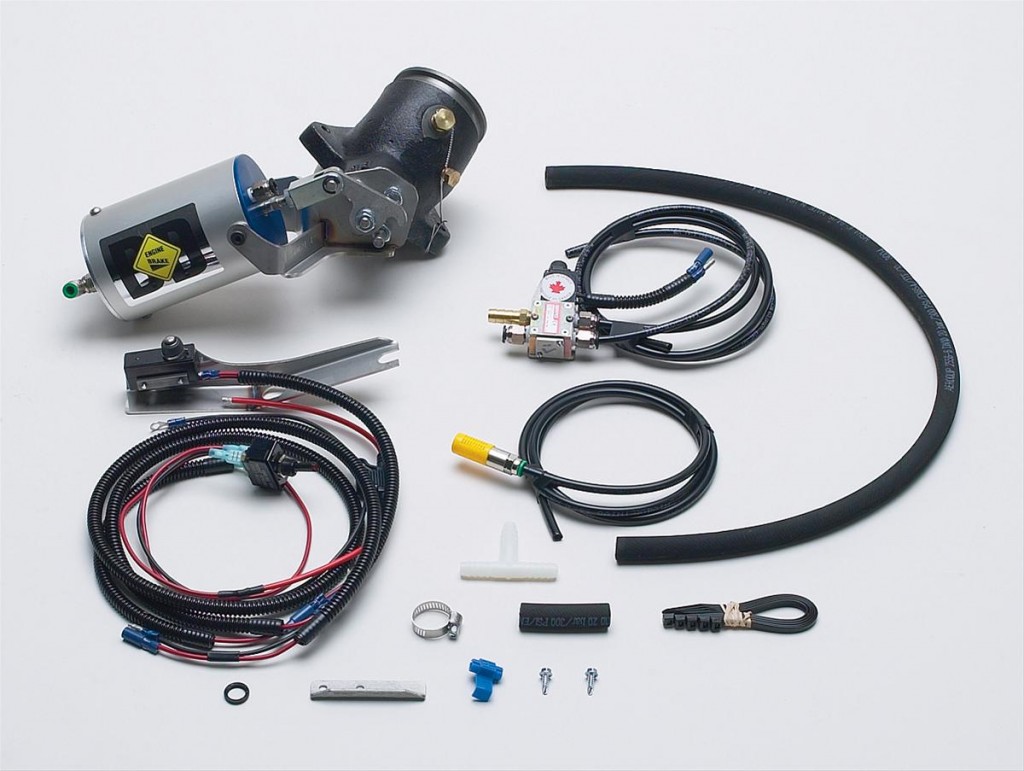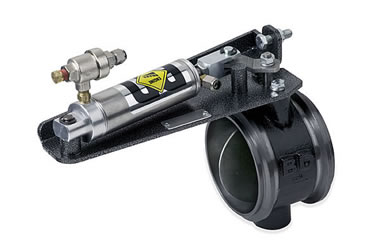It’s a beautiful Saturday afternoon. You’re towing your race car merrily along with your diesel-powered rig, when you suddenly encounter a hilly, winding stretch of highway. You pump the brakes to navigate your way down a steep section of road, but the additional weight of the trailer causes your tow vehicle to pick up speed instead. As momentum rapidly increases, your brakes become overpowered, overmatched, and ineffective.
At this point, you’ve learned what professional truck drivers have known for years: Conventional brakes alone are not sufficient for slowing heavily-weighted vehicles. This is especially true for diesel-powered vehicles, where downshifting is not an option. That’s why big rigs and other large, cargo-style diesel trucks have come equipped with auxiliary brakes for years. Known as engine brakes, or “Jake Brakes,” these auxiliary brakes give diesel-powered vehicles added stopping power whenever and wherever needed.
These days, you don’t have to drive an 18-wheeler-or even a truck with a manual transmission-to get the safety and performance advantages of auxiliary brakes. Thanks to companies like BD Diesel, you can add the benefits of an exhaust brake to your diesel-powered tow vehicle or work truck.
The Basics On Brakes
BD Diesel manufactures a full line of exhaust brakes and accessories for most popular diesel pickups, including GM Duramax, Ford Powerstroke, and Dodge Cummins trucks. Exhaust brakes perform the same function as traditional engine brakes found on 18-wheelers in that they create a mechanical braking effect by retarding horsepower production. While engine brakes accomplish this by altering engine valve timing, exhaust brakes are designed to restrict exhaust flow out of the engine. This yields quick, consistent retarding force throughout the engine rpm range, along with much quieter performance than true engine brakes.
Not Just For Manuals
Exhaust brakes are at their most efficient when the lockup clutch plates in the torque converter are locked together. However, most automatic transmissions simply don’t supply the signal to keep the convertor locked up when you remove your foot from the throttle pedal. When lock up is held in there is not enough pressure to hold the lockup clutch plates together under exhaust brake conditions. In fact, stock automatic transmissions provide lowest hydraulic pressure when your foot is off the accelerator-right at the time exhaust brakes are most likely in use. That means your torque converter is prone to excess slippage, which prevents 100 percent of the retarding force from reaching the ground. In addition, excessive converter slippage in automatic transmissions can cause extreme heat buildup and premature transmission wear.
To make exhaust brakes more efficient in stock automatic transmission applications, BD Diesel offers plug-in accessories such as the PressureLoc. The PressureLoc gives your torque converter the physical ability to remain locked up under intense exhaust brake conditions by increasing the transmission’s hydraulic pressure every time converter lockup engages. This pressure increase holds the converter’s lockup clutch plates together longer, reducing converter slippage during lockup conditions.
Whereas the PressureLoc essentially acts as the muscles for your torque converter by holding the clutch plates together longer, BD Diesel’s AutoLoc computer works as the brains. Designed to work with the PressureLoc, the AutoLoc automatically commands the torque converter to remain locked up when the exhaust brake is applied. Together, the AutoLoc and PressureLoc ensure that the torque converter locks up tightly when deceleration is needed. That allows 100 percent of the retarding force to reach the wheels and eliminates heat buildup and transmission wear due to excessive torque converter slippage.
As an option to the AutoLoc system, BD Diesel offers the TorqLoc computer. The TorqLoc acts much the same way as the AutoLoc computer, but offers added versatility. The TorqLoc takes lockup control away from your stock computer and allows you to operate the convertor in one of three modes. The first mode manually locks up the converter on command. The second mode allows the converter to operate under stock conditions. The third option maintains converter lockup only when the vehicle’s stock computer has established a circuit which is just like the AutoLoc. This option allows you to operate the exhaust brake under throttle and is designed for use in heavy power or extreme load situations.
BD Diesel makes a variety of other accessories to help you get the most from your exhaust brake. Products include the BD TowLoc computer, which allows you to adjust things like disengage speed, fourth-to-third gear downshift, torque converter lockout speed, and many more personal driving requirements with the use of a lap top computer. You can also get transmission valve body upgrades and complete transmission upgrade kits to help bolster your transmission.
The Exhaust Brake Advantage
The safety and performance benefits of BD Diesel exhaust brakes and accessories are no-brainers. An exhaust brake gives you increased vehicle control under heavy load and improved stopping power, particularly on hilly roads.
Exhaust brakes also act as a brake reserve, so you can take some of the stress off of your conventional brakes. Use of an exhaust brake, even in situations where your regular brakes are sufficient, will reduce wear and tear with very minimal effect on your vehicle’s drivability and fuel economy. In the long run, you’ll be less likely to experience overheating, premature wear, and damage to your brake components.
If you tow a trailer, haul large loads, or pull a fifth-wheel with a diesel pickup, you should consider putting an exhaust brake to work for you. It can help prevent your conventional brakes-and your entire truck-from going downhill fast.












Is there a vid on the retarder and bed torqloc
Bd torqloc
For a 2003 dodge 3500 diesel
I have a 98 Dodge Ram 2500. I have upgraded the exhaust valve springs to 60lbs springs and will soon upgrade the torque convertor to a 47/48RE Goerend “DA” Triple Disk. I am planning on installing a BDD-2033135 exhaust brake. My question is….. is there anything else I need, to make this work successfully?